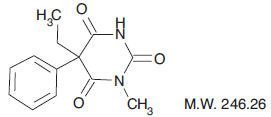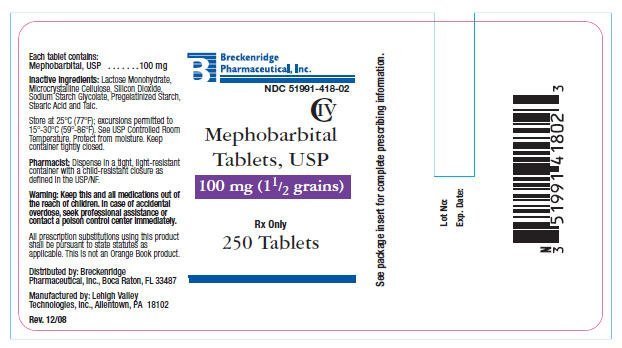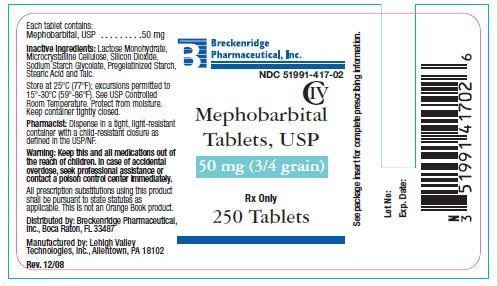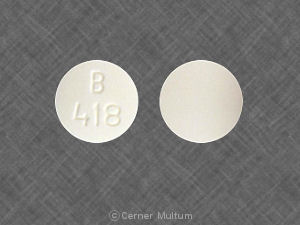Mephobarbital: Package Insert / Prescribing Info
Package insert / product label
Dosage form: tablet
Drug classes: Barbiturate anticonvulsants, Barbiturates
Medically reviewed by Drugs.com. Last updated on Mar 25, 2024.
On This Page
Mephobarbital Description
Mephobarbital, 5-Ethyl-1-methyl-5-phenylbarbituric acid, is a barbiturate with sedative, hypnotic, and anticonvulsant properties. It occurs as a white, nearly odorless, tasteless powder and is slightly soluble in water and in alcohol.
Mephobarbital tablets are available for oral administration.
The structural formula is:

Inactive Ingredients: Lactose Monohydrate, Microcrystalline Cellulose, Silicon Dioxide, Sodium Starch Glycolate, Pregelatinized Starch, Stearic Acid, Talc.
Mephobarbital - Clinical Pharmacology
Barbiturates are capable of producing all levels of CNS mood alteration from excitation to mild sedation, to hypnosis, and deep coma. Overdosage can produce death. In high enough therapeutic doses, barbiturates induce anesthesia.
Barbiturates depress the sensory cortex, decrease motor activity, alter cerebellar function, and produce drowsiness, sedation, and hypnosis.
Barbiturates are respiratory depressants. The degree of respiratory depression is dependent upon dose. With hypnotic doses, respiratory depression produced by barbiturates is similar to that which occurs during physiologic sleep with slight decrease in blood pressure and heart rate.
Studies in laboratory animals have shown that barbiturates cause reduction in the tone and contractility of the uterus, ureters, and urinary bladder. However, concentrations of the drugs required to produce this effect in humans are not reached with sedative-hypnotic doses.
Barbiturates do not impair normal hepatic function, but have been shown to induce liver microsomal enzymes, thus increasing and/or altering the metabolism of barbiturates and other drugs. (See PRECAUTIONS-Drug Interactions.)
Mephobarbital tablets exerts a strong sedative and anticonvulsant action but has a relatively mild hypnotic effect. It reduces the incidence of epileptic seizures in grand mal and petit mal. Mephobarbital tablets usually causes little or no drowsiness or lassitude. Hence, when it is used as a sedative or anticonvulsant, patients usually become more calm, more cheerful, and better adjusted to their surroundings without clouding of mental faculties. Mephobarbital tablets are reported to produce less sedation than does phenobarbital.
Barbiturates are weak acids that are absorbed and rapidly distributed to all tissues and fluids with high concentrations in the brain, liver, and kidneys. Lipid solubility of the barbiturates is the dominant factor in their distribution within the body.
Barbiturates are bound to plasma and tissue proteins to a varying degree with the degree of binding increasing directly as a function of lipid solubility.
Approximately 50% of an oral dose of mephobarbital is absorbed from the gastrointestinal tract. Therapeutic plasma concentrations for mephobarbital have not been established nor has the half-life been determined. Following oral administration, the onset of action of the drug is 30 to 60 minutes and the duration of action is 10 to 16 hours. The primary route of mephobarbital metabolism is N-demethylation by the microsomal enzymes of the liver to form phenobarbital. Phenobarbital may be excreted in the urine unchanged or further metabolized to p-hydroxyphenobarbital and excreted in the urine as glucuronide or sulfate conjugates. About 75% of a single oral dose of mephobarbital is converted to phenobarbital in 24 hours.
Therefore, chronic administration of mephobarbital may lead to an accumulation of phenobarbital (not mephobarbital) in plasma. It has not been determined whether mephobarbital or phenobarbital is the active agent during long-time mephobarbital therapy.
Indications and Usage for Mephobarbital
Mephobarbital tablets are indicated for use as a sedative for the relief of anxiety, tension, and apprehension, and as an anticonvulsant for the treatment of grand mal and petit mal epilepsy.
Warnings
Habit Forming
Barbiturates may be habit forming. Tolerance, psychological, and physical dependence may occur with continued use. (See DRUG ABUSE AND DEPENDENCE and CLINICAL PHARMACOLOGY.) Patients who have psychological dependence on barbiturates may increase the dosage or decrease the dosage interval without consulting a physician and may subsequently develop a physical dependence on barbiturates. To minimize the possibility of overdosage or the development of dependence, the prescribing and dispensing of sedative-hypnotic barbiturates should be limited to the amount required for the interval until the next appointment. Abrupt cessation after prolonged use in the dependent person may result in withdrawal symptoms, including delirium, convulsions, and possibly death. Barbiturates should be withdrawn gradually from any patient known to be taking excessive dosage over long periods of time. (See DRUG ABUSE AND DEPENDENCE.)
Acute or Chronic Pain
Caution should be exercised when barbiturates are administered to patients with acute or chronic pain, because paradoxical excitement could be induced or important symptoms could be masked. However, the use of barbiturates as sedatives in the postoperative surgical period and as adjuncts to cancer chemotherapy is well established.
Use in Pregnancy
Barbiturates can cause fetal damage when administered to a pregnant woman. Retrospective, case-controlled studies have suggested a connection between the maternal consumption of barbiturates and a higher than expected incidence of fetal abnormalities. Following oral or parenteral administration, barbiturates readily cross the placental barrier and are distributed throughout fetal tissues with highest concentrations found in the placenta, fetal liver, and brain. Fetal blood levels approach maternal blood levels following parenteral administration.
Withdrawal symptoms occur in infants born to mothers who receive barbiturates throughout the last trimester of pregnancy. (See DRUG ABUSE AND DEPENDENCE.) If this drug is used during pregnancy, or if the patient becomes pregnant while taking this drug, the patient should be apprised of the potential hazard to the fetus.
Precautions
General
Barbiturates may be habit forming. Tolerance and psychological and physical dependence may occur with continuing use. (See DRUG ABUSE AND DEPENDENCE.) Barbiturates should be administered with caution, if at all, to patients who are mentally depressed, have suicidal tendencies, or a history of drug abuse.
Elderly or debilitated patients may react to barbiturates with marked excitement, depression, and confusion. In some persons, barbiturates repeatedly produce excitement rather than depression.
In patients with hepatic damage, barbiturates should be administered with caution and initially in reduced doses. Barbiturates should not be administered to patients showing the premonitory signs of hepatic coma.
Status epilepticus may result from the abrupt discontinuation of Mephobarbital tablets, even when administered in small daily doses in the treatment of epilepsy.
Caution and careful adjustment of dosage are required when Mephobarbital tablets are used in patients with impaired renal, cardiac or respiratory function, and in patients with myasthenia gravis and myxedema. The least quantity feasible should be prescribed or dispensed at any one time in order to minimize the possibility of acute or chronic overdosage.
Information for the Patient
Practitioners should give the following information and instructions to patients receiving barbiturates.
- The use of barbiturates carries with it an associated risk of psychological and/or physical dependence. The patient should be warned against increasing the dose of the drug without consulting a physician.
- Barbiturates may impair mental and/or physical abilities required for the performance of potentially hazardous tasks (e.g., driving, operating machinery, etc.).
- Alcohol should not be consumed while taking barbiturates. Concurrent use of the barbiturates with other CNS depressants (e.g., alcohol, narcotics, tranquilizers, and antihistamines) may result in additional CNS depressant effects.
Laboratory Tests
Prolonged therapy with barbiturates should be accompanied by periodic laboratory evaluation of organ systems, including hematopoietic, renal, and hepatic systems. (See PRECAUTIONS [General] and ADVERSE REACTIONS.)
Drug Interactions
Most reports of clinically significant drug interactions occurring with barbiturates have involved phenobarbital. However, the application of these data to other barbiturates appears valid and warrants serial blood level determinations of the relevant drugs when there are multiple therapies.
- Anticoagulants. Phenobarbital lowers the plasma levels of dicumarol (name previously used: bishydroxycoumarin) and causes a decrease in anticoagulant activity as measured by the prothrombin time. Barbiturates can induce hepatic microsomal enzymes resulting in increased metabolism and decreased anticoagulant response of oral anticoagulants (e.g., warfarin, acenocoumarol, dicumarol, and phenprocoumon). Patients stabilized on anticoagulant therapy may require dosage adjustments if barbiturates are added to or withdrawn from their dosage regimen.
- Corticosteroids. Barbiturates appear to enhance the metabolism of exogenous corticosteroids probably through the induction of hepatic microsomal enzymes. Patients stabilized on corticosteroid therapy may require dosage adjustments if barbiturates are added to or withdrawn from their dosage regimen.
- Griseofulvin. Phenobarbital appears to interfere with the absorption of orally administered griseofulvin, thus decreasing its blood level. The effect of the resultant decreased blood levels of griseofulvin on therapeutic response has not been established. However, it would be preferable to avoid concomitant administration of these drugs.
- Doxycycline. Phenobarbital has been shown to shorten the half-life of doxycycline for as long as 2 weeks after barbiturate therapy is discontinued. This mechanism is probably through the induction of hepatic microsomal enzymes that metabolize the antibiotic. If phenobarbital and doxycycline are administered concurrently, the clinical response to doxycycline should be monitored closely.
- Phenytoin, Sodium Valproate, Valproic Acid. The effect of barbiturates on the metabolism of phenytoin appears to be variable. Some investigators report an accelerating effect, while others report no effect. Because the effect of barbiturates on the metabolism of phenytoin is not predictable, phenytoin and barbiturate blood levels should be monitored more frequently if these drugs are given concurrently. Sodium valproate and valproic acid appear to decrease barbiturate metabolism; therefore, barbiturate blood levels should be monitored and appropriate dosage adjustments made as indicated.
- Central Nervous System Depressants. The concomitant use of other central nervous system depressants, including other sedatives or hypnotics, antihistamines, tranquilizers, or alcohol, may produce additive depressant effects.
- Monoamine Oxidase Inhibitors (MAOI, or for 14 days after stopping MAOI therapy). MAOI's prolong the effects of barbiturates probably because metabolism of the barbiturate is inhibited.
- Estradiol, Estrone, Progesterone, and other Steroidal Hormones. Pretreatment with or concurrent administration of phenobarbital may decrease the effect of estradiol by increasing its metabolism. There have been reports of patients treated with antiepileptic drugs (e.g., phenobarbital) who become pregnant while taking oral contraceptives. An alternate contraceptive method might be suggested to women taking phenobarbital.
Carcinogenesis
Animal Data
Phenobarbital sodium is carcinogenic in mice and rats after lifetime administration. In mice, it produced benign and malignant liver cell tumors. In rats, benign liver cell tumors were observed very late in life. Phenobarbital is the major metabolite of Mephobarbital tablets.
Human Data
In a 29-year epidemiological study of 9,136 patients who were treated on an anticonvulsant protocol which included phenobarbital, results indicated a higher than normal incidence of hepatic carcinoma. Previously, some of these patients were treated with thorotrast, a drug which is known to produce hepatic carcinomas. Thus, this study did not provide sufficient evidence that Phenobarbital sodium is carcinogenic in humans. phenobarbital is the major metabolite of Mephobarbital tablets.
A retrospective study of 84 children with brain tumors matched to 73 normal controls and 78 cancer controls (malignant disease other than brain tumors) suggested an association between exposure to barbiturates prenatally and an increased incidence of brain tumors.
Pregnancy
Nonteratogenic Effects
Reports of infants suffering from long-term barbiturate exposure in utero included the acute withdrawal syndrome of seizures and hyperirritability from birth to a delayed onset of up to 14 days. (See DRUG ABUSE AND DEPENDENCE.)
Labor and Delivery
Hypnotic doses of these barbiturates do not appear to significantly impair uterine activity during labor. Full anesthetic doses of barbiturates decrease the force and frequency of uterine contractions. Administration of sedative-hypnotic barbiturates to the mother during labor may result in respiratory depression in the newborn. Premature infants are particularly susceptible to the depressant effects of barbiturates. If barbiturates are used during labor and delivery, resuscitation equipment should be available.
Data are currently not available to evaluate the effect of these barbiturates when forceps delivery or other intervention is necessary. Also, data are not available to determine the effect of these barbiturates on the later growth, development, and functional maturation of the child.
Adverse Reactions/Side Effects
The following adverse reactions and their incidence were compiled from surveillance of thousands of hospitalized patients. Because such patients may be less aware of the certain milder adverse effects of barbiturates, the incidence of these reactions may be somewhat higher in fully ambulatory patients.
More than 1 in 100 Patients. The most common adverse reactions estimated to occur at a rate of 1 to 3 patients per 100 is:
Nervous System: Somnolence.
Less than 1 in 100 Patients. Adverse reactions estimated to occur at a rate of less than 1 in 100 patients listed below, grouped by organ system, and by decreasing order of occurrence are:
Nervous System: Agitation, confusion, hyperkinesia, ataxia, CNS depression, nightmares, nervousness, psychiatric disturbance, hallucinations, insomnia, anxiety, dizziness, thinking abnormality.
Respiratory System: Hypoventilation, apnea.
Cardiovascular System: Bradycardia, hypotension, syncope.
Digestive System: Nausea, vomiting, constipation.
Other Reported Reactions: Headache, hypersensitivity reactions (angioedema, skin rashes, exfoliative dermatitis), fever, liver damage, megaloblastic anemia following chronic phenobarbital use.
Drug Abuse and Dependence
Mephobarbital is a controlled substance in Narcotic Schedule IV. Barbiturates may be habit forming. Tolerance, psychological dependence, and physical dependence may occur especially following prolonged use of high doses of barbiturates. As tolerance to barbiturates develops, the amount needed to maintain the same level of intoxication increases tolerance to a fatal dosage, however, does not increase more than two-fold. As this occurs, the margin between an intoxicating dosage and fatal dosage becomes smaller.
Symptoms of acute intoxication with barbiturates include unsteady gait, slurred speech, and sustained nystagmus. Mental signs of chronic intoxication include confusion, poor judgment, irritability, insomnia, and somatic complaints.
Symptoms of barbiturate dependence are similar to those of chronic alcoholism. If an individual appears to be intoxicated with alcohol to a degree that is radically disproportionate to the amount of alcohol in his or her blood the use of barbiturates should be suspected. The lethal dose of a barbiturate is far less if alcohol is also ingested.
The symptoms of barbiturate withdrawal can be severe and may cause death. Minor withdrawal symptoms may appear 8 to 12 hours after the last dose of a barbiturate. These symptoms usually appear in the following order: anxiety, muscle twitching, tremor of hands and fingers, progressive weakness, dizziness, distortion in visual perception, nausea, vomiting, insomnia, and orthostatic hypotension. Major withdrawal symptoms (convulsions and delirium) may occur within 16 hours and last up to 5 days after abrupt cessation of these drugs. Intensity of withdrawal symptoms gradually declines over a period of approximately 15 days. Individuals susceptible to a barbiturate abuse and dependence include alcoholics and opiate abusers, as well as other sedative-hypnotic and amphetamine abusers.
Drug dependence to barbiturates arises from repeated administration of a barbiturate or agent with barbiturate-like effect on a continuous basis, generally in amounts exceeding therapeutic dose levels. The characteristics of drug dependence to barbiturates include: (a) a strong desire or need to continue taking the drug; (b) a tendency to increase the dose; (c) a psychic dependence on the effects of the drug related to subjective and individual appreciation of those effects; and (d) a physical dependence on the effects of the drug requiring its presence for maintenance of homeostasis and resulting in a definite, characteristic, and self-limited abstinence syndrome when the drug is withdrawn.
Treatment of barbiturate dependence consists of cautious and gradual withdrawal of the drug. Barbiturate-dependent patients can be withdrawn by using a number of different withdrawal regimens. In all cases withdrawal takes an extended period of time. One method involves substituting a 30 mg dose of phenobarbital for each 100 mg to 200 mg dose of barbiturate that the patient has been taking.The total daily amount of phenobarbital is then administered in 3 to 4 divided doses, not to exceed 600 mg daily. Should signs of withdrawal occur on the first day of treatment, a loading dose of 100 mg to 200 mg of phenobarbital may be administered IM in addition to the oral dose. After stabilization on phenobarbital, the total daily dose is decreased by 30 mg a day as long as withdrawal is proceeding smoothly. A modification of this regimen involves initiating treatment at the patient's regular dosage level and decreasing the daily dosage by 10% if tolerated by the patient.
Infants physically dependent on barbiturates may be given phenobarbital 3 mg/kg/day to 10 mg/kg/day. After withdrawal symptoms (hyperactivity, disturbed sleep, tremors, hyperreflexia) are relieved, the dosage of phenobarbital should be gradually decreased and completely withdrawn over a 2-week period.
Overdosage
The toxic dose of barbiturates varies considerably. In general, an oral dose of 1 g of most barbiturates produces serious poisoning in an adult. Death commonly occurs after 2 g to 10 g of ingested barbiturate. Barbiturate intoxication may be confused with alcoholism, bromide intoxication, and with various neurological disorders.
Acute overdosage with barbiturates is manifested by CNS and respiratory depression which may progress to Cheyne- Stokes respiration, areflexia, constriction of the pupils to a slight degree (though in severe poisoning they may show paralytic dilation), oliguria, tachycardia, hypotension, lowered body temperature, and coma. Typical shock syndrome (apnea, circulatory collapse, respiratory arrest, and death) may occur.
In extreme overdose, all electrical activity in the brain may cease, in which case a "flat" EEG normally equated with clinical death cannot be accepted. This effect is fully reversible unless hypoxic damage occurs. Consideration should be given to the possibility of barbiturate intoxication even in situations that appear to involve trauma.
Complications such as pneumonia, pulmonary edema, cardiac arrhythmias, congestive heart failure, and renal failure may occur. Uremia may increase CNS sensitivity to barbiturates if renal function is impaired. Differential diagnosis should include hypoglycemia, head trauma, cerebrovascular accidents, convulsive states, and diabetic coma.
Treatment of overdosage is mainly supportive and consists of the following:
- Maintenance of an adequate airway, with assisted respiration and oxygen administration as necessary.
- Monitoring of vital signs and fluid balance.
- If the patient is conscious and has not lost the gag reflex, emesis may be induced with ipecac. Care should be taken to prevent pulmonary aspiration of vomitus. After completion of vomiting, 30 g activated charcoal in a glass of water may be administered.
- If emesis is contraindicated, gastric lavage may be performed with a cuffed endotracheal tube in place with the patient in the face down position. Activated charcoal may be left in the emptied stomach and a saline cathartic administered.
- Fluid therapy and other standard treatment for shock, if needed.
- If renal function is normal, forced diuresis may aid in the elimination of the barbiturate. Alkalinization of the urine increases renal excretion of some barbiturates, including mephobarbital (which is metabolized to phenobarbital).
- Although not recommended as a routine procedure, hemodialysis may be used in severe barbiturate intoxications or if the patient is anuric or in shock.
- Patient should be rolled from side to side every 30 minutes.
- Antibiotics should be given if pneumonia is suspected.
- Appropriate nursing care to prevent hypostatic pneumonia, decubiti aspiration, and other complications of patients with altered states of consciousness.
Mephobarbital Dosage and Administration
Epilepsy
Average dose for adults and children 12 years of age and older: 400 mg to 600 mg (6 grains to 9 grains) daily. Mephobarbital tablets are best taken at bedtime if seizures generally occur at night, and during the day if attacks are diurnal.
Treatment should be started with a small dose which is gradually increased over four or five days until the optimum dosage is determined. If the patient has been taking some other antiepileptic drug, it should be tapered off as the doses of Mephobarbital tablets are increased, to guard against the temporary marked attacks that may occur when any treatment for epilepsy is changed abruptly. Similarly, when the dose is lowered to a maintenance level or to be discontinued, the amount should be, reduced gradually over four or five days.
Special Patient Population
Dosage should be reduced in the elderly or debilitated because these patients may be more sensitive to barbiturates. Dosage should be reduced for patients with impaired renal function or hepatic disease.
Combination with Other Drugs
Mephobarbital tablets may be used in combination with phenobarbital, either in the form of alternating courses or concurrently. When the two drugs are used at the same time, the dose should be about one-half the amount of each used alone. The average daily dose for an adult is from 50 mg to 100 mg (3/4 grain to 1 1/2 grains) of phenobarbital and from 200 mg to 300 mg (3 grains to 4 1/2 grains) of Mephobarbital tablets.
Mephobarbital tablets may also be used with phenytoin sodium; in some cases, combined therapy appears to give better results than either agent used alone, since phenytoin sodium is particularly effective for the psychomotor types of seizure but relatively ineffective for petit mal. When the drugs are employed concurrently, a reduced dose of phenytoin sodium is advisable, but the full dose of Mephobarbital tablets may be given. Satisfactory results have been obtained with an average daily dose of 230 mg (3 1/2 grains) of phenytoin sodium plus about 600 mg (9 grains) of Mephobarbital tablets.
How is Mephobarbital supplied
Mephobarbital Tablets are available as white, round, convex tablets. The 32 mg tablet is scored.
32 mg (1/2 grain), bottles of 250 (NDC 51991-416-02. Imprint B416).
50 mg (3/4 grain), bottles of 250 (NDC 51991-417-02. Imprint B417).
100 mg (1 1/2 grains), bottles of 250 (NDC 51991-418-02. Imprint B418).
Keep this and all medications out of the reach of children. In case of accidental overdose, seek professional assistance or call a poison control center immediately.
Store at 25° C (77° F); excursions permitted to 15°-30° C (59°-86° F). See USP Controlled Room Temperature.
Pharmacist: Dispense in a tight, light-resistant container with a child-resistant closure as defined in the USP/NF.
All prescription substitutions using this product shall be pursuant to state statutes as applicable. This is not an Orange Book product.
Manufactured by: Lehigh Valley Technologies Inc. Allentown, PA 18102
Distributed by: Breckenridge Pharmaceutical, Inc. Boca Raton, FL 33487
REV. 12/08
| MEPHOBARBITAL
mephobarbital tablet |
||||||||||||||||||
|
||||||||||||||||||
|
||||||||||||||||||
|
||||||||||||||||||
|
||||||||||||||||||
|
||||||||||||||||||
|
||||||||||||||||||
| MEPHOBARBITAL
mephobarbital tablet |
||||||||||||||||||
|
||||||||||||||||||
|
||||||||||||||||||
|
||||||||||||||||||
|
||||||||||||||||||
|
||||||||||||||||||
|
||||||||||||||||||
| Labeler - Breckenridge Pharmaceutical, Inc. (150554335) |
| Establishment | |||
| Name | Address | ID/FEI | Business Operations |
|---|---|---|---|
| Lehigh Valley Technologies | 113290444 | MANUFACTURE | |
More about mephobarbital
- Check interactions
- Compare alternatives
- Reviews (4)
- Drug images
- Side effects
- Dosage information
- During pregnancy
- Drug class: barbiturate anticonvulsants



